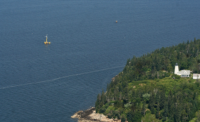The University of Maine is launching a specialized training program to equip students and industry professionals with design, construction and technology expertise and skills in the fast-developing state offshore wind energy sector—particularly for projects planned in deeper state waters that require more complex floating turbines, transmission innovations and co-existance with the marine environment.
OffshoreWind4Maine, set to begin in March, is designed to initially provide specialized undergraduate courses and onsite experiences for UMaine students. In the future the program will be open to students from other colleges and to high and middle school students and working professionals.
Offshore wind development isn't simple and requires “overlapping expertise in several disciplines of ocean science and engineering,” says Amrit Verma, program leader and assistant professor of mechanical engineering at the university’s Orono campus.
The training is a partnership of the engineering department, the university’s Advanced Structures and Composite Center—its offshore wind R&D unit—and its School of Marine Science.
The new offerings are set to benefit more than 300 undergraduate and graduate students in a single year, said the school.
Funded by a $266,669 grant from Maine Gov. Janet Mills, the program will include new courses, micro-credentials and the university's first undergraduate concentration in offshore wind energy development. A unique interdisciplinary course will "train students in identifying and solving stakeholder challenges associated with offshore wind development in the Gulf of Maine and abroad,” Verma says.
Through the program, UMaine students will learn "employability skills,” he adds.
Mills has a stated goals of creating 30,000 clean energy jobs in Maine by 2030 and becoming carbon-neutral by 2045.
New micro-credentials will include offshore wind model testing, lab instrumentation, marine species protection and use of remotely operated vehicles.
Curriculum development for pre-college students is also set to gain through the program, Verma says. The university already sponsors the annual Windstorm Challenge, a free engineering competition for state middle and high school students to design and test a floating offshore wind hull.
Strong Winds, New Development
High wind speeds in the Gulf of Maine are forecast to produce 156 GW of potential energy, says the state, with about 89% of that in deep waters that drop to about 200 ft deep at three nautical miles from shore.
The university is a leading U.S. R&D center for floating offshore wind energy, with its patented floating concrete VolturnUS hull technology now in use on New England Aqua Ventus, an 11-MW single floating turbine pilot project that is the first to be grid-connected in the U.S.and has funding support from RWE Renewables and a Mitsubishi Corp. subsidiary.
Operating in state waters, it is in the permitting stage with plans for commercialization in 2024.
This month, those two firms were among five developers responding with proposals to the US Interior Dept., as it assesses commercial interest in an estimated 13.7 million acres of federal waters in the Gulf of Maine that New England officials estimate could supply up to 40 GW of regional power capacity by 2050.
A four-year Interior Dept. strategy released in 2021 includes a goal to hold a commercial lease sale in 2024. The department held one earlier this month for two areas off the coast of California that also would require floating wind projects in that area's deeper water. Five lease sites were auctioned for $757 million.
Maine also has applied for a 15.2-sq-mile federal site to develop the first U.S. floating offshore wind research array, with 12 floating turbines that it says could produce up to 144 MW of renewable energy.
The Biden Administration has set a U.S. goal for clean energy development that includes 15 GW of floating offshore wind energy by 2035.




Post a comment to this article
Report Abusive Comment